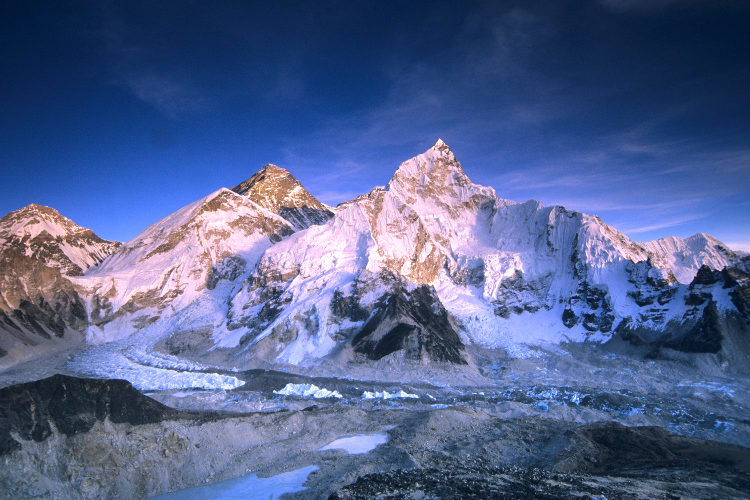
But today, the trek to Everest Base Camp has become an achievable goal for people from all walks of life who want a glimpse of the world’s highest peak. In 2012, between 35,000 and 37,000 people trekked in the Everest region.
Aside from breathtaking scenery, travellers to the region can experience unique Sherpa culture by visiting monasteries and museums along the way. Days are filled with walking for the sheer pleasure of it, past colourful prayer wheels and across swing bridges straight out of an Indiana Jones movie, while evenings are rewarded with hot food and conversation with like-minded people around the dining-room fire.
The heady mix of natural beauty, fascinating culture and a personal sense of achievement, as well as warm Nepalese hospitality from the people of the Solukhumbu region, makes the Everest Base Camp trek one of the world’s most unforgettable.
From March to May and from September to December. It gets hot in May, just before the monsoon season; be prepared for possible rain. December reaches below-zero temperatures but the days are still beautiful and there are fewer trekkers (but remember to wrap up warm in the evenings).
The Nepal government is considering making the hiring of a guide compulsory this season, after the disappearances of some lone trekkers and the death of a Belgian trekker in the Langtang region in June 2012.
But the solo trekking ban has been put on hold, so for now it’s still possible to go it alone. But hiring a guide or porter has many advantages: for US$10 to $20 a day you’re giving someone a valuable job and in turn you will learn plenty about the local culture and natural environment.
A trekking company offers the advantage of having everything arranged for you, including airport transfers, accommodation and porters and/or guides and their insurance. You can book before you go with western tour companies, though you’ll pay significantly less by booking in Kathmandu – ensure they’re registered with the Trekking Agencies Association of Nepal (TAAN). For a list of registered companies visit www.taan.org.np.
Nothing can really prepare you for the trek’s extreme hills and altitude of up to 5545m. But don’t be put off – people with average fitness can do this trek. ‘Slow and steady’ is the key to achieving, and enjoying, your trek.
Prepare with cardiovascular training several times a week: cycling, swimming, hill climbing and lots of walking. Aim for a five-hour walk once a week. Seek out hills or find a tall building and repeatedly walk up and down the stairs.
Pack lightly – aim for 10 to 15kg. Consider your porter’s load before you include that big bottle of shampoo or pair of jeans.
A fleece jacket, down jacket and thermal underwear are a must, as the Himalaya gets cold above 3000m any time of the year. Also take two pairs of long pants, two or three T-shirts (synthetic fabrics – not cotton – that wick away sweat), and another warm jumper or light fleece.
Footwear requires lightly broken-in boots, trekking socks, and sneakers or sandals for evenings. You will also need a raincoat, gloves, woollen hat, sunhat and polarised sunglasses. A good sleeping bag (rated to -20°C/0°F) is essential; if it’s winter, a thermal liner makes it extra toasty.
Opt for travel-size toiletries, including a good sunscreen, lip balm, travel towel and tissues. Baby wipes are handy for days when you can’t shower.
Your first aid kit should include medication for diarrhoea, antibiotics for a chest or sinus infection, and adhesive bandages for blisters. Visit your doctor for Nepal-specific immunisations. Using two 1L water bottles with water purification tablets is a reliable and safe way to drink water – and more environmentally friendly than buying bottled water from lodges.
Take your time. Altitude sickness can affect anybody – even the extremely fit. (The acclimatisation days, usually at Namche and Dingboche, are set for a reason.) Watch for signs of altitude sickness: symptoms include headaches, dizziness, sleeplessness, loss of appetite and breathlessness. Bring a supply of the medication Diamox for treatment; if symptoms persist, descend.
Be vegetarian. As tempting as it is to try a juicy yak steak or ‘buff burger’, be aware that all meat is carried up by porters from below Lukla due to the no-killing policy in Sagamartha National Park, so by the time you have it, it’s getting old. The safest, healthiest option is to eat dal bhat (lentil soup with rice) – it’s made fresh daily and is a great source of protein and energy. As the saying goes, ‘Dal bhat power, 24 hour!’
Cover up. The sun here is harsh, so use a good sunscreen and reapply regularly. Wear long-sleeved tops, long pants and a light scarf – or be prepared to blister.